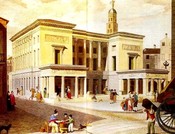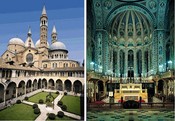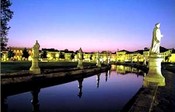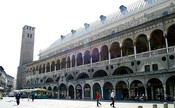|
|
 |

Padua, arts' city






|
Better known as the city of St. Anthony, Padua is one of the major art cities in Italy, characterised by 3000 years of history.
Since the 4th century b.C. Patavium was the most important centre of the Veneto region and then it became one of the most prosperous cities of the Roman empire.
In 602 the city was totally destroyed by the Langobards and the rebuilding proceeded very slowly.
In the 12th century Padua became a free city. In the following two centuries it reached the height of its political power thanks to the reign of the Carraresi (1338-1404) and it experienced a great cultural, economic and religious frenzy.
The medieval town walls, the large civil and religious buildings, especially the Basilica del Santo and the University are the evidence of an extraordinary period, marked by artists as Giotto, Guariento, Giusto de' Menabuoi e Altichiero.
In 1405 Padua became part of the mainland of Venice, but thanks to Donatello and Mantegna it maintained artistic superiority until the middle of the 15th century .
In the 16th century, under Venetian dominion, Padua experienced a great renewal: new public buildings and majestic churches were built.
With the construction of Prato della Valle toward the end of the 18th century the Venetian dominion ended after four hundred years. In 1866 it became part of the Italian kingdom and took part to the two world wars, suffering from numerous bombings. After the war the city developed quickly and became one of the main economical centres of northern Italy.
Padua is one of the most visited tourist destination in Italy; the religious heritage is extraordinarily rich. First of all the Basilica of St. Antonio, this majestic church was built in 1232 and inside it contains masterpieces of the highest artistic value.
Other important churches are the Basilica of St. Giustina and the Cathedral with the adjacent Baptistery of the twelfth century. The Baptistery has been frescoed by Giusto de' Menabuoi.
A unique masterpiece in the world is the Scrovegni Chapel, the inside has been completely frescoed by Giotto between 1303 and 1305 containing scenes about the life of Jesus and Mary.
Padua has many important civil palaces and buildings too. The most important one is the "Palazzo della Ragione" built in 1218. Its grandeur is incomparable with any other public building, erected in the European cities during the 13th century.
Padua has a historical university complex with the Palazzo del Bo, the Anatomy theatre, the Botanical garden, the Specola and several museums.
Padua has beautiful squares such as Prato della Valle, Piazza della Frutta and delle Erbe, "Piazza dei Signori" where the visitor can discover the architectures, the porticos, Palazzo della Ragione, the clock tower, the Loggia della Gran Guardia…and to conclude the most famous Coffee House in Padua, the Pedrocchi.
|
|
 |
|